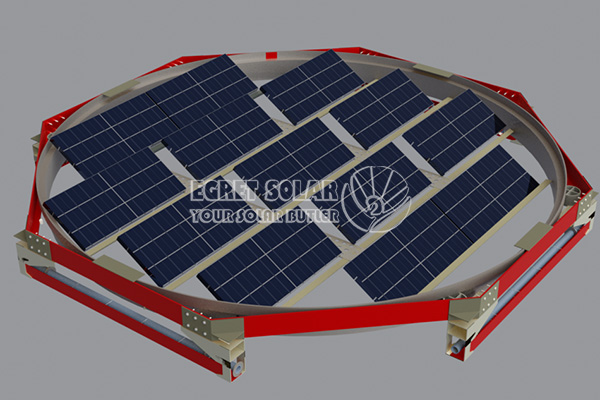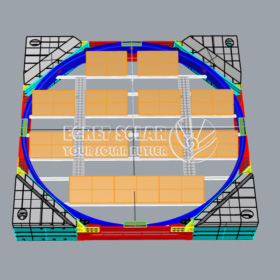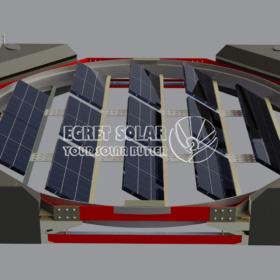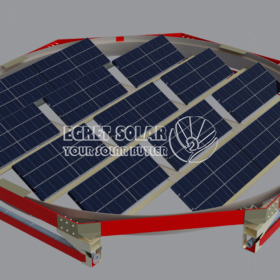- English
- Español
- Português
- русский
- Français
- 日本語
- Deutsch
- tiếng Việt
- Italiano
- Nederlands
- ภาษาไทย
- Polski
- 한국어
- Svenska
- magyar
- Malay
- বাংলা ভাষার
- Dansk
- Suomi
- हिन्दी
- Pilipino
- Türkçe
- Gaeilge
- العربية
- Indonesia
- Norsk
- تمل
- český
- ελληνικά
- український
- Javanese
- فارسی
- தமிழ்
- తెలుగు
- नेपाली
- Burmese
- български
- ລາວ
- Latine
- Қазақша
- Euskal
- Azərbaycan
- Slovenský jazyk
- Македонски
- Lietuvos
- Eesti Keel
- Română
- Slovenski
- मराठी
- Srpski језик
Combining floating PV with compressed air energy storage
2025-01-03
Researchers from Egypt and the UK developed a new floating PV system concept that utilizes compressed air for energy storage. The system has a round-trip efficiency of 34.1% and an energy efficiency of 41%.

Scientists from the Port Said University in Egypt and the University of Strathclyde in the United Kingdom have proposed to combine compressed air energy storage (CAES) with floating photovoltaic through a novel energy management strategy.
“To overcome the intermittency and availability issues of solar energy, the proposed floating PV system is equipped with an environmentally friendly hybrid compressed air energy storage system controlled by a novel energy management strategy to efficiently manage the power flow between the system's components without exceeding their allowable operational limits for safe operation,” the research's lead author, Erkan Oterkus, told pv magazine. “This control strategy is designed to ensure fulfilling the load requirements and utilizing even the low-grade PV power production, which reduces any power waste and improves the system efficiency.”
In the proposed concept, the energy management strategy follows the deterministic rule-based approach, which determines the rules with the aid of a fuel economy or emissions map of the system in question. “This approach utilizes the human expertise, intuition, heuristics, and mathematical models to generate a set of predetermined rules which control the operation of the system components,” the group stressed. “These rules are interpret-able and can be tuned for better performance of different operational scenarios with low computational burdens.”
The 5 kW prototype utilizes partially floated PV panels that are in a continuous direct contact with the surrounding water, which provides an efficient and free cooling and improves the PV panels' efficiency as a result of the thermal equilibrium with the surrounding water. The floating platform used to support the PV system is capable of tracking the sunlight automatically for more solar energy production and altering the submergence ratio by adjusting the platform's draft and the PV panels' tilt angle to control their cooling or cleaning them from any accumulated dust or fully submerging the PV panels to avoid any damage during severe weather conditions.



The storage system is described as a adiabatic CAES system integrated with thermal energy storage (TES). It consists of four uncompensated air steel tanks that are placed at the corners of the floating platform. “Prior to air storage, the hot compressed air is cooled down in the heat ex-changer,” the researchers explained. “Whenever the generated PV electricity is lower or higher than the required power by the air compressors, it is proposed to store this electricity in the form of heat in a TES.”
A hot water tank is also integrated with a heat ex-changer to raise the temperature of the compressed air prior to its expansion. The compressed air is released and heated through the hot water tank before its expansion in the expander to regenerate electricity using the generator.
Through a series of simulations, the research team found that the system has a round-trip efficiency of 34.1% and an energy efficiency of 41%, with the strongest system performance being observed between December and January. “Compared to conventional CAES systems, the proposed hybrid CAES system has an annual fuel saving of 126.4 of natural gas,” the academics emphasized. “This fuel saving will also result in an economic benefit by reducing the system operational cost by $27,690/year of fuel cost.”
They also found that the system’s energy and exergy efficiency can be considerably affected by the efficiency of individual components, which they said can decrease under off-design and partial load operation conditions.
The system was described in “Hybrid compressed air energy storage system and control strategy for a partially floating photovoltaic plant,” published in Energy.
At Egret Solar, we are excited about the potential of combining floating photovoltaic (PV) systems with compressed air energy storage (CAES). This innovative approach holds immense promise for addressing some of the key challenges facing the renewable energy industry today, such as energy storage, grid stability, and the efficient use of space. Egret Solar is excited about the long-term potential of combining floating PV with compressed air energy storage. This pairing represents a cutting-edge solution that addresses some of the most pressing challenges in the renewable energy industry while promoting a greener, more sustainable future.




